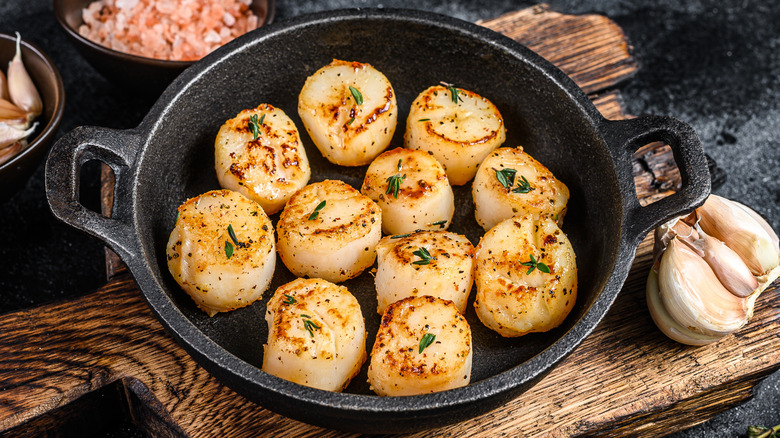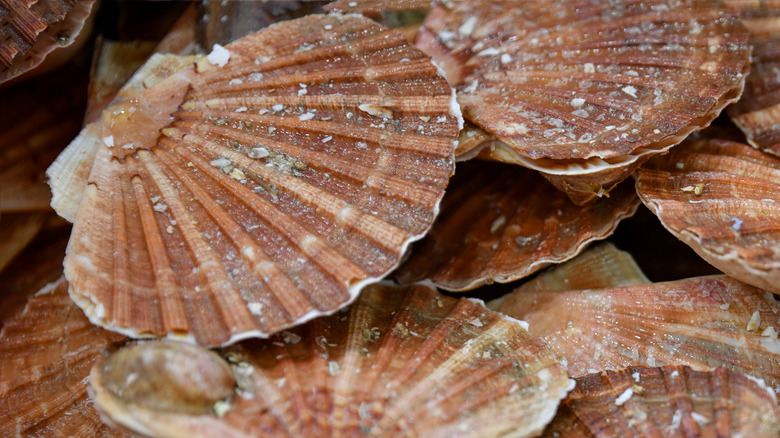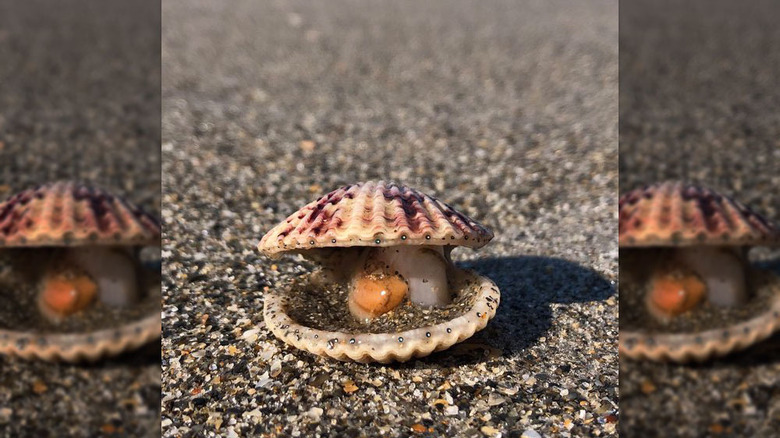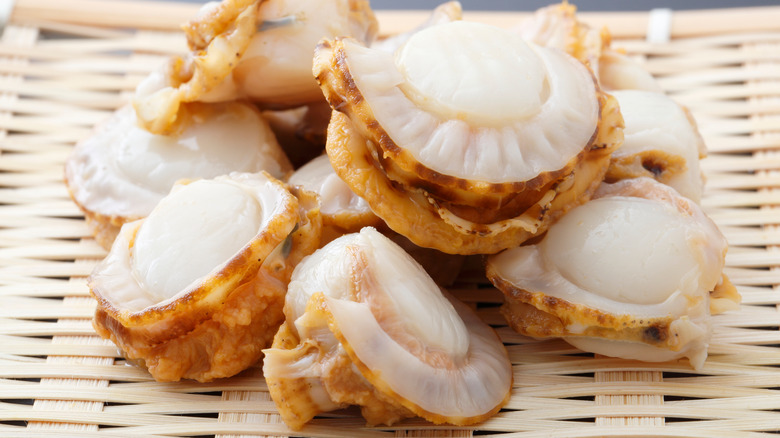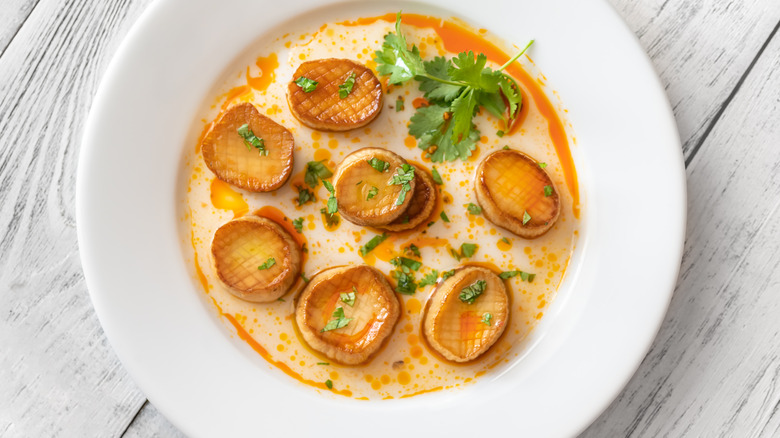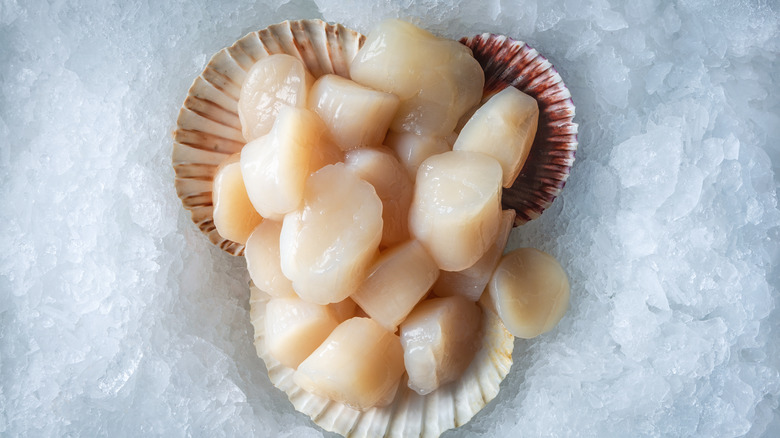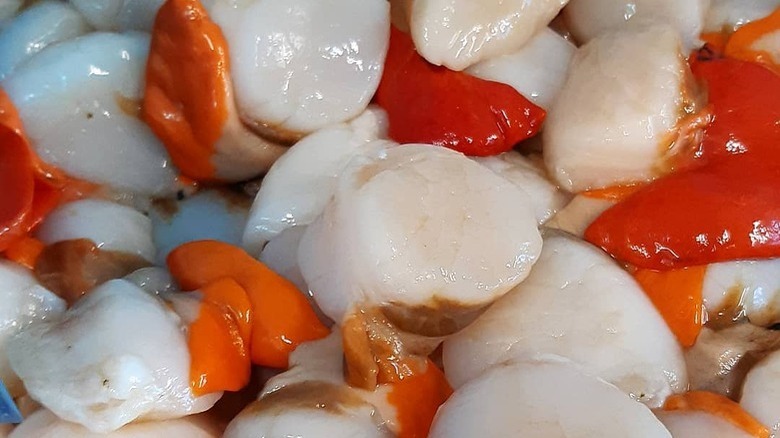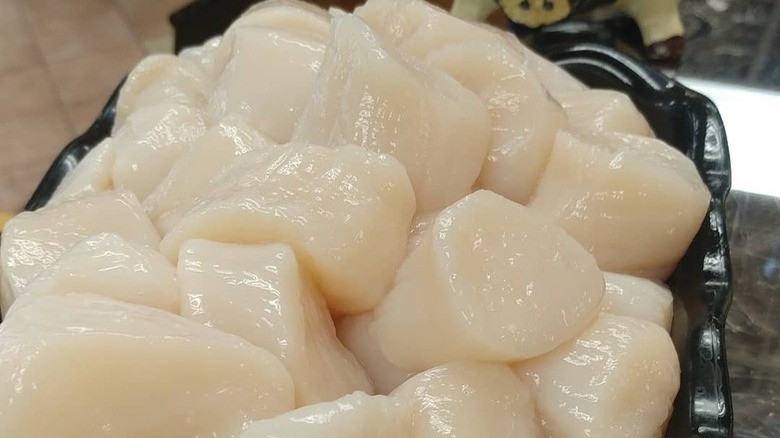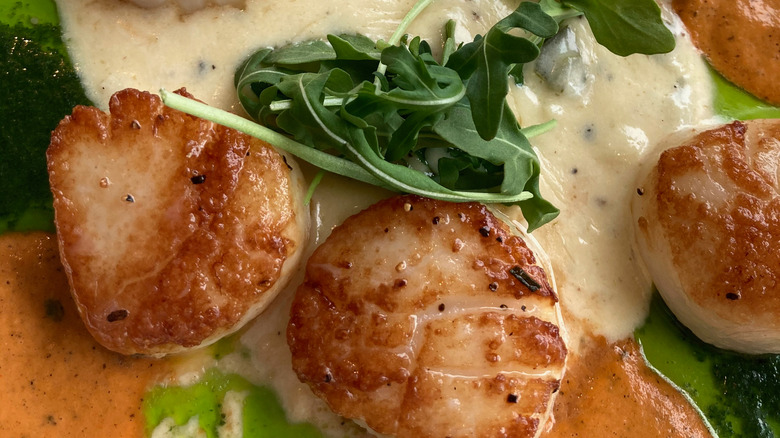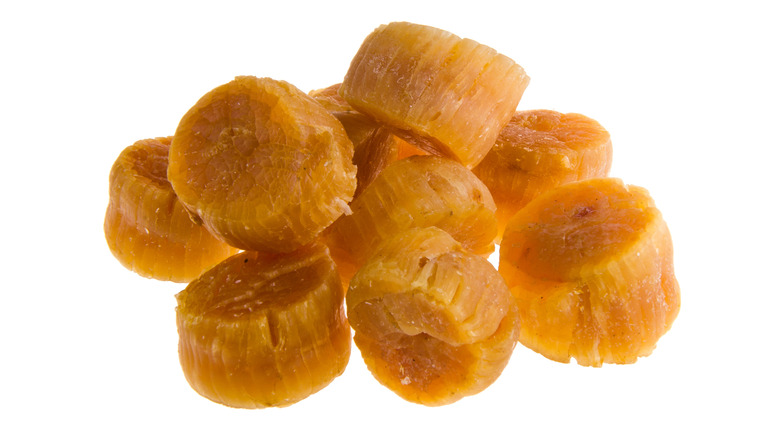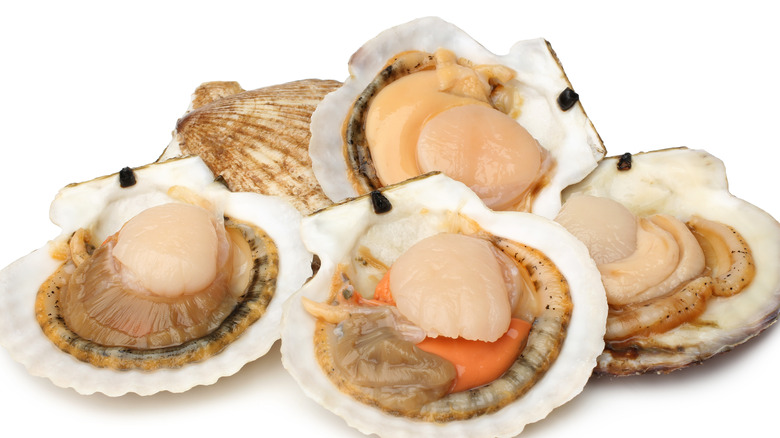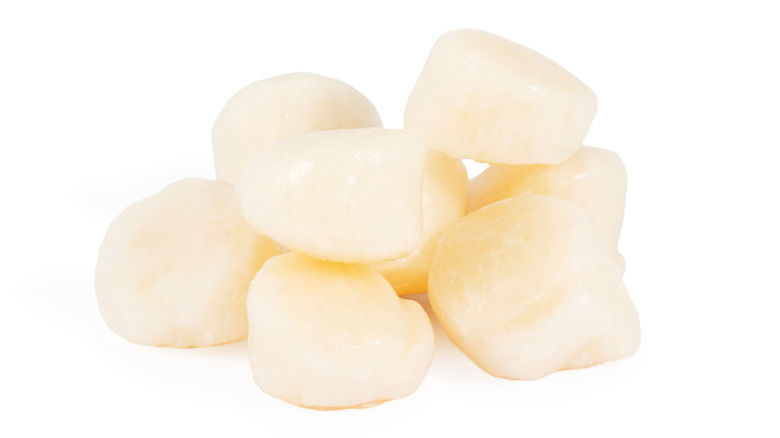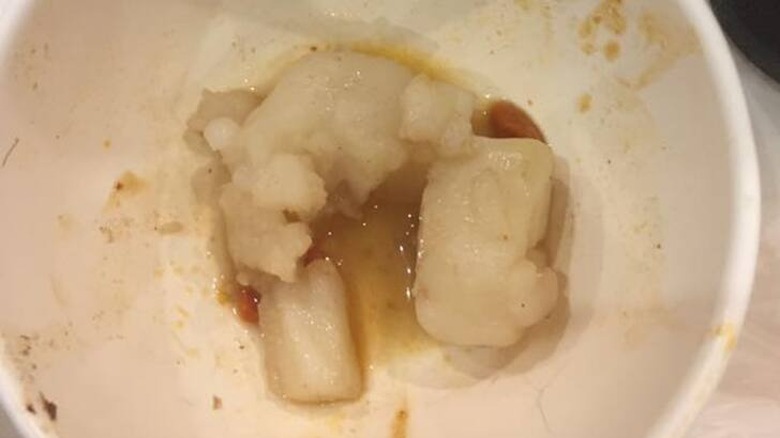8 Types Of Scallops And What To Know About Them
Sweet, buttery, and creamy, scallops were once considered an expensive delicacy fit only for royalty. While they are no longer regarded as rich man's food, they are still pretty pricey. And this is primarily due to the supply-and-demand concept. Scallops aren't readily available since they are challenging to catch and farm and are easily perishable. However, their demand is pretty high, courtesy of their unmatched flavor profile and extensive range of ways to cook the perfect scallops.
More importantly, they are full of health benefits. According to WebMD, scallops are loaded with omega-3 fatty acids, which can do wonders for your skin and heart health. And since scallops are low-calorie seafood, they are perfect for weight-conscious folks looking to up their protein intake, per Healthline. As impressive as scallops are, they are a confusing species. From dry versus wet scallops to divers and day boats, there's a lot to them. We are here to clear the air. This article discusses the common scallop varieties and ways to cook each mollusk. We'll also discuss how you can store them and how to avoid buying fake scallops. Yes, that's right: Fake scallops exist.
Atlantic sea scallops
Atlantic sea scallops are typically 6-inch-long mollusks, with the largest reported at 9 inches. Does the size matter? It does if they taste delicious. Who doesn't want a mouthful of seafood goodness? However, even with their size, these beautiful marine species weren't a popular choice until the early 19th century. Early New England settlers with access to wide seafood varieties and Atlantic sea scallops weren't their first choice, according to Saving Seafood. One reason was their taste.
Times changed, and culinary experts from the U.S. started to include scallops in their cookbooks, making the scallops an excellent seafood option. You can cook these scallops in a delicious lemony pan-seared dish or a hearty ceviche. However, for a crusty pan-seared scallop dish, never go for the treated "wet" scallops you see in the supermarkets. They will never sear properly. Instead, go for the dry scallops, and when you do, try scallops with garlic.
Calico scallops
Inhabiting the after-storm shores of Florida, this variety of shellfish comes in several exotic shell colors, perfect for a collector's treasure. In contrast to the large Atlantic sea scallops, calico scallop shells can grow only up to 2.4 inches (via Florida Fish and Wildlife Conservation Commission). According to the Shell Museum, calico scallops have several pairs of eyes. Although you may not believe it, the small organs that line the edge of the calico scallop's shell are its eyes.
Despite their enticing appearance, Robust Kitchen says they "aren't as sweet or succulent as sea or bay scallops." That means you can find these scallops for cheaper rates, but expect a chewier texture than other varieties. You can combine calico scallops in a scallop and shrimp scampi or use them in a scallop chowder to get the most out of them.
Bay scallops
Perhaps the best tasting scallop variety on this list, bay scallops are typically harvested off the east coast, from Canada to North Carolina. They are pretty small, though. Because of their size, you usually get 70 to 100 of them in a pound (via Seafood Source).
Although close relatives of the Atlantic sea scallops, bay scallops are tremendously different in size. That size difference also affects the taste and cooking preferences. While the sea scallops are large, they may take longer to make than the bay scallops. As such, it's better not to use the two varieties interchangeably while cooking. Bay scallops are generally sweeter than sea scallops, and their texture varies. They are also more tender than their cousins. You can eat them by sautéeing them or steaming them with herbs and spices, like dill and pepper.
King scallops
Also known as great scallops, king scallops differ significantly from the other varieties. For one, they have religious connotations. The shells of these species are a symbol of pilgrimage to Santiago de Compostela (where the shrine of Saint James is situated). For this reason, the king scallops are also called "pilgrim scallops." Another religious connotation of these scallops is with the Goddess Venus, which represents femininity and fertility (via Trinity College Dublin).
Per Good Food, king scallops are sold with their richly colored roe, which makes them stand apart from other types of scallops. You can find them in half-shells too. According to MarLIN, king scallops on the shores of Ireland can grow up to 10 to 11 centimeters in the first four years of their lives — not the largest of their kin, but still the kings. You can enjoy these mollusks with their roe by pan-searing them and serving them with a mildly seasoned sauce that doesn't overshadow the taste of these succulent scallops.
Queen scallops
Queen scallops, or Queenies, are the royalty of the waters around the Isle of Man in the Irish Sea. Although the species is not as popular as its counterpart, king scallops, locals celebrate it as one of their delicacies. According to the EU Food Policy Team, Queenies come in various colors, from yellow, orange, and red to brown and purple. The edible adductor muscle is only 20 millimeters in diameter and 15 millimeters high, so you can easily gulp down one in a single bite.
Similar to the king scallops, these queens are sold with their edible roe. However, it depends on the cook if they want to keep or discard the eggs. According to Seapedia, these mollusks have flat, round valves with about 20 age rings, and the shell colors can vary from red, orange, blotchy, or solid white. Taste Atlas says these Isle of Man Queenies have a sweet flavor and lots of cooking uses. You can consume these succulent scallops in salads, bake them, or lightly sear them to get a crisp exterior and a tender interior.
Tasmanian scallops
According to Sea-Ex, Tasmanian scallops — also known as southern scallops or commercial scallops — are harvested from the Australian waters from mid-New South Wales to mid-Western Australia. These mollusks get their name from the territories they are harvested from. NSW, Tasmania, and Victoria are the main shores where fishmongers trawl the sea floor with square dredges that catch them. The two valves of a Tasmanian scallop are different from each other. The bottom shell is straighter, so the shellfish can rest on it for growth. The upper valve is thin and concave and covers the scallop's body.
Opening these shellfish up requires a sharp knife, Sea-Ex notes. Make sure that you cut the adductor muscle where it is attached to the shell. Once done, you only need to put pressure on the knife to open the shell. The taste of Tasmanian scallops is sweet and nutty. You can eat them barbecue or grilled. However, overcooking these mollusks will yield chewy meat, a chef's worst nightmare. So, when cooking with these scallops, take extra care not to go overboard with the cooking time.
Dayboat scallops
Under the sea scallops category, there are a few local varieties as well. One is dayboat scallops, which get their name from their harvesting method. Caught from the waters of Maine, these dayboat scallops are harvested in specialized boats that have a restriction to get back to the shore within 24 hours of their short sea trips to make sure the catch is fresh (via Maine Lobster Now).
The Kitchen restaurant details the preparation process once the dayboats arrive back ashore. Dayboat scallops are quickly shucked and put on ice. There's no chemical treatment involved, so you can expect these sea jewels to be fresh and full-flavored with pinkish-white flesh. You can enjoy these sweet, succulent marine animals by pan-searing them with minimum spice. Moreover, they go well with salads since there's no freezing involved. Direct selling and lack of treatment make dayboat scallops pricier than other varieties, but every penny is worth the taste.
Diver scallops
Do diver scallops really dive? Well, no, they swim like their brethren, flapping their shells. The name is actually inspired by the fact that divers harvest them with their hands from the seafloor. However, not all divers can catch these critters. Only licensed divers can perform the task, and even then, it requires specialized scuba gear. Technically, diver scallops belong under the umbrella term sea scallops, but they are not common sea scallops. Only one fishery in the U.S. catches these beautiful beings and has a dedicated task force. The harvest only accounts for 1% of the total scallop harvest in the country (via The Edible Ocean).
According to New England Today, dayboat scallops and diver scallops are the same species harvested from the waters of Maine. The key difference is the harvesting methods: by boat or by hand. While you can expect them to be incredibly fresh, they are generally expensive due to the eco-friendly and difficult method they are harvested, notes Maine Lobster Now. The cooking methods for this delicacy remain consistent with other scallop cooking methods. Grilling, barbecuing, and pan-searing all work well with these beauties.
Wet vs. dry scallops: What's the difference?
If you're a scallop lover, you've probably come across the wet and dry labels on scallop packets at your local grocery store. So, how are they different? Per Michael Anne Rowe, an Emmy Award-winning food and travel journalist, wet or dry labels do not signify a specific species of scallops but rather the treatment method after harvesting them. FishEx details how wet scallops are dealt with: Those labeled as ”wet” are soaked in phosphates. This treatment increases their shelf life and makes them whiter and fuller. However, the soaking means you will get fewer scallops per pound. That is because while the phosphates preserve them, it also adds water weight, and you'll be paying for the water.
On the other hand, ”dry” scallops are sold unpreserved. The obvious differences between the two types are their appearance and their taste. While wet scallops are white, dry scallops look vanilla in color, according to Michael Anne Rowe. Dry scallops are considered better than wet scallops. Though phosphates can retain the wet scallop's moisture, the flavor can be soapy, and they shrink when cooked. Conversely, dry scallops are simply caught from the water, shucked, and then frozen with no additives or preservatives whatsoever. The result is exceptionally sweet and succulent scallops that can be seared to perfection and don't release a significant amount of moisture while cooking.
How to tell if scallops have gone bad?
There's nothing else worse than a batch of scallops gone bad. If you don't want to give yourself a nasty case of food poisoning, you should discard them immediately. So, how can you recognize a bad scallop from a fresh one?
Well, for starters, scallops that have gone bad tend to have strong ammonia or metallic taste. Fresh scallops, on the other hand, don't have any unpleasant smell. Fresh scallops also have creamy white to beige color, per eHow. If there are hints of different colors like if it's largely brown, it's a clear sign that the scallops have started going bad. Another thing to look at in fresh scallops is their texture which should be firm to touch and not wobbly. Oven Via advises sniff-testing fresh scallops. If they smell sour or too fishy, they have gone bad. The slimy texture is another indicator that the seafood is not fit for consumption. While buying live mollusks, go for sealed shells. If unsealed, touch the shellfish to check its response. In the case of a dead mollusk, touching it will not get a reaction. A live scallop will go inside its shell.
How to store scallops the right way?
Scallops are certainly not cheap to come by. So when you get your hands on them, you must store them properly. According to the U.S. Department of Agriculture, scallops or any seafood should not stay in the refrigerator for more than two days when raw. If cooked, they can remain in the fridge for three to four days. Freezing them is another story, though. You can freeze raw scallops for three to 12 months, but the texture of the meat will change after some time, so it's better to consume them as early as possible.
Seafood Health Facts says you should store raw and cooked seafood separately, and they should not come in contact with each other. The same applies to scallops, too, because raw scallops can carry toxic algal growth, per Fisheries Science. To freeze the scallops, put them in a moisture-resistant wrap or freezer bag at the coldest part of the freezer. However, it is always better to consume fresh food. So if you're buying fresh scallops, consume them at the earliest. Fresh scallops also cook way better than frozen ones.
How can you tell if scallops are fake?
According to Statista, the average scallop price in the U.S. in 2019 was $9.14 per pound. That makes scallops an expensive seafood choice. So it's no surprise that the seafood market is flooded with fake scallops. Unfortunately, these counterfeit products don't have telltale signs of forgery. However, you can spot them through keen observation. Per author Dr. David Friedman, fake scallops are either cut out of shark meat, stingray, skate, or a solidified paste of surimi with other additives. You can identify such products by looking at their size. Unlike genuine scallops, which typically vary in size, fake scallops are usually cookie-cutter shaped because that's how it is made — with an actual cookie cutter.
Another factor to look at is the smell, which will be fishy and not sweet or salty. On the appearance front, fake mollusks will appear denser than their authentic selves. Another essential factor that Dr. Friedman notes is that scallops are typically sold by weight, and companies generally tend to add more water to drive their prices. Rusty spoon notes that fake scallops can have another layer to them, such as misleading labels, and the outlet says it's not required by law for fake scallops to be listed as, well, fake.
